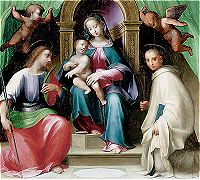 click to enlarge |
VIRGIN & CHILD IN MAJESTY WITH SS QUENTIN & PLACIDUS SN 28, oil on panel Domenico Puligo From "The Pages"
|
ARTIST:
A Florentine High Renaissance painter, Domenico Puligo was born in Florence in 1492 & died of the plague there in 1527. He trained in Florence with Ridolfo Ghirlandaio, & in the workshops of Antonio Ceraiulo & Andrea del Sarto. His paintings reflect the style of Fra Bartolomeo & Raphael with the figures in the manner of Sarto. He is described by Vasari as a lazy artist. He painted altar pieces & portraits. These show interest in the latest models of Rahael & Titian – ¾ length standing figures.
SUBJECT:
The enthroned Virgin holding the Christ child is flanked on either side by kneeling saints. Two putti in diaphanous tunics hover in the air, pulling back green curtains to enable the viewer to witness the scene. The saint on the right is traditionally identified as St Placidus; he wears a white Benedictine habit, & lifts his skirt to show his black scapula. He holds a book & the palm of martyrdom. The identification of the figure kneeling on the left (holding 2 spits and 2 martyr’s palms) has been problematic. Originally he was identified as Quentin, then as St Benignus, then again as Quentin. The spits are symbols of their outrageously tortured deaths.
Re Placidus: b. 515. His father sent him to live & study at St Benedict’s monastery near Rome. During his childhood he was saved from drowning by St Maurus. At his death he was venerated as a holy monk.
THE PAINTING:
The work is thought to have been painted between 1521-22, according to the stylistic evidence of the Virgin’s youth, idealized face, lowered eyes, pose, & treatment of drapery (Gardner, 1986).
The simple, balanced, pyramidal composition is typical Florentine classicism of the High Renaissance. Puligo did not overload his paintings with detail. He painted in a misty sfumato, which softness enhances the tenderness between Mother & Child & expresses a mood of sentimental sweetness & serenity.
The painting’s colors are typical of Puligo’s range & are especially luminous in this work, showing a high level of refinement. The Virgin is dressed in crimson trimmed with gold, covered by a blue-green robe lined in grey-purple. St. Quentin’s shirt is grey, lightened with yellow. The robe about his lower torso is a vibrant light scarlet. St. Placidus wears the white Benedictine robe of his order, as noted.
This altarpiece came from the Cistercian Abbey St. Salvatore in Badia a Settino, where his relics are said to be preserved. [This is not the painting commissioned in 1525 for the altar of St Benignus in Genoa, Italy.]
Additional References:
Rev. S. Baring Gould, MA. “Lives of the Saints,” 1914, Vol 12, pp 120-125, 725-728
Crowe, J.A.-Cavaliaselle, G.B. “A History of Painting in Umbria, Florence, & Siena,“ 1914, Vol VI, p 96
Benson, Robert. “The Holford Collection,” 1924, pp 54-55
Venturi, “Storia del’Arte Italiana,” 1932, pp234-239
Gronau, C. Thieme-Becker Kunsterlexicon, 1933, Vol XXVII, p 459
Freedburg, S.J. “Paintings of the High Renaissance in Rome & Florence,” pp1961, pp497-500
“Paintings in Italy 1500-1600,” 1971, pp156-157
Gardner, Genette Ann. “The Paintings of Domenico Puligo,” 1986, Vols I & II, pp 6-9; 22-27; 190-193;
393-394; 398-402; 410
Alter, Rosalyn. “A Florentine Artist’s Altarpiece Depicts Virgin & Saints,” Spring-Summer, 1990. The
John & Mable Ringling Museum of Art, pp 1-7
Vasari, Giorgio. “Lives of the Painters, Sculptors, & Architects,” 1996. Translated by Gaston De Vere, introduced by David Ehserjian, pp 767-771